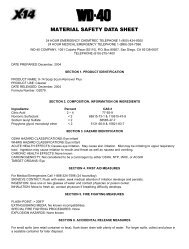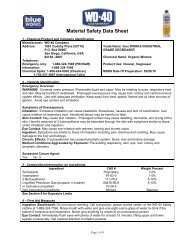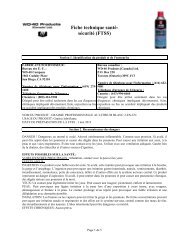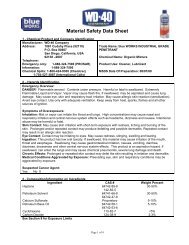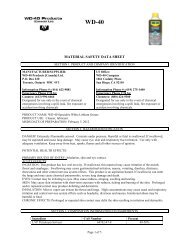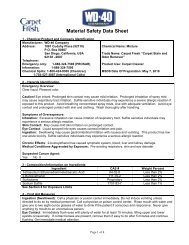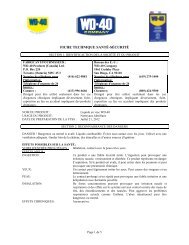Material Safety Data Sheet (MSDS) - WD-40
Material Safety Data Sheet (MSDS) - WD-40
Material Safety Data Sheet (MSDS) - WD-40
You also want an ePaper? Increase the reach of your titles
YUMPU automatically turns print PDFs into web optimized ePapers that Google loves.
4 – First Aid Measures<br />
Ingestion (Swallowed): Ingestion of significant amounts is very unlikely due to product form, however liquid<br />
contents are an Aspiration Hazard. DO NOT induce vomiting. Call physician, poison control center or the<br />
<strong>WD</strong>-<strong>40</strong> <strong>Safety</strong> Hotline at 1-888-324-7596 immediately.<br />
Eye Contact: Flush thoroughly with water. Get medical attention if irritation persists.<br />
Skin Contact: Wash with soap and water. If irritation develops and persists, get medical attention.<br />
Inhalation (Breathing): Inhalation overexposure is very unlikely due to product form. If irritation is<br />
experienced, move to fresh air. Get medical attention if irritation or other symptoms develop and persist<br />
5 – Fire Fighting Measures<br />
Extinguishing Media: Use water fog, dry chemical, carbon dioxide or foam.<br />
Special Fire Fighting Procedures: Firefighters should always wear positive pressure self-contained<br />
breathing apparatus and full protective clothing.<br />
Unusual Fire and Explosion Hazards: The liquid contents of the pen are not flammable but will burn under<br />
fire conditions. However, the pen contains a small amount of the liquid and the contents are released only<br />
when pressure is applied to the tip. The product presents only a minimal fire hazard.<br />
6 – Accidental Release Measures<br />
Large spills of this product are unlikely due to product form. If pen leaks, wipe up any free liquid and place the<br />
pen and the waste in an appropriate container for disposal. In manufacturing and storage where large<br />
numbers of pens may be damaged, eliminate all sources of ignition, ventilate area and collect the pens into a<br />
container for disposal. Collect any released liquid with an inert absorbent and place in a container for<br />
disposal.<br />
7 – Handling and Storage<br />
Handling: Keep product away from open flame. Keep away from children. Replace cap on pen when not in<br />
use. Avoid contact with eyes. Avoid prolonged contact with skin.<br />
Storage: Store away from excessive heat and flames.<br />
8 – Exposure Controls/Personal Protection<br />
Chemical<br />
Occupational Exposure Limits<br />
Aliphatic Petroleum Distillates<br />
Petroleum Base Oil<br />
Non-Hazardous Ingredients<br />
1200 mg/m3 TWA Manufacturer Recommended<br />
5 mg/m3 TWA OSHA PEL/ACGIH TLV<br />
10 mg/m3 STEL ACGIH TLV<br />
None Established<br />
Engineering Controls: No special ventilation is normally required.<br />
Personal Protection:<br />
Eye Protection: None should be needed for normal use. Avoid eye contact.<br />
Skin Protection: None needed for normal use. Avoid repeated or prolonged contact with skin. Wear<br />
impervious gloves if needed to prevent possible skin irritation<br />
Respiratory Protection: None should be needed for normal use.<br />
Work/Hygiene Practices: Wash with soap and water after handling.<br />
Note: For bulk processing, general body-covering clothing, safety goggles and impervious gloves are<br />
recommended as good industrial hygiene practice. If needed, a NIOSH approved respirator appropriate for<br />
the level of exposure should be worn.<br />
9 – Physical and Chemical Properties<br />
Boiling Point: 323F Specific Gravity: 0.832 @ 72F<br />
Solubility in Water: Insoluble pH: Not Applicable<br />
Vapor Pressure: 0.07 mmHg @ 20°C (aliphatic Vapor Density: Greater than 1<br />
Page 2 of 4



